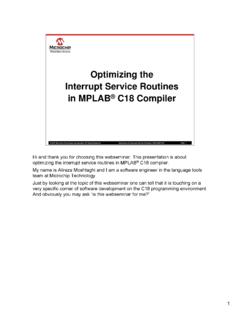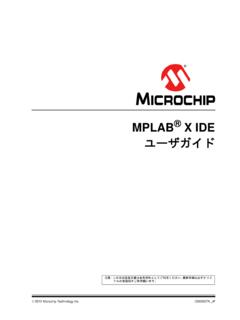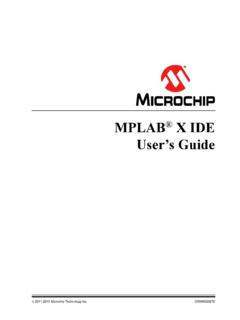Transcription of For MPLAB X IDE - Microchip Technology
1 2012-2014 Microchip Technology ICD 3In-Circuit DebuggerUser s GuideFor MPLAB X IDEDS50002081B-page 2 2012-2014 Microchip Technology contained in this publication regarding deviceapplications and the like is provided only for your convenienceand may be superseded by updates. It is your responsibility toensure that your application meets with your MAKES NO REPRESENTATIONS ORWARRANTIES OF ANY KIND WHETHER EXPRESS ORIMPLIED, WRITTEN OR ORAL, STATUTORY OROTHERWISE, RELATED TO THE INFORMATION,INCLUDING BUT NOT LIMITED TO ITS CONDITION,QUALITY, PERFORMANCE, MERCHANTABILITY ORFITNESS FOR PURPOSE. Microchip disclaims all liabilityarising from this information and its use. Use of Microchipdevices in life support and/or safety applications is entirely atthe buyer s risk, and the buyer agrees to defend, indemnify andhold harmless Microchip from any and all damages, claims,suits, or expenses resulting from such use.
2 No licenses areconveyed, implicitly or otherwise, under any Microchipintellectual property the following details of the code protection feature on Microchip devices: Microchip products meet the specification contained in their particular Microchip Data Sheet. Microchip believes that its family of products is one of the most secure families of its kind on the market today, when used in the intended manner and under normal conditions. There are dishonest and possibly illegal methods used to breach the code protection feature. All of these methods, to our knowledge, require using the Microchip products in a manner outside the operating specifications contained in Microchip s Data Sheets. Most likely, the person doing so is engaged in theft of intellectual property. Microchip is willing to work with the customer who is concerned about the integrity of their code.
3 Neither Microchip nor any other semiconductor manufacturer can guarantee the security of their code. Code protection does not mean that we are guaranteeing the product as unbreakable. Code protection is constantly evolving. We at Microchip are committed to continuously improving the code protection features of ourproducts. Attempts to break Microchip s code protection feature may be a violation of the Digital Millennium Copyright Act. If such actsallow unauthorized access to your software or other copyrighted work, you may have a right to sue for relief under that received ISO/TS-16949:2009 certification for its worldwide headquarters, design and wafer fabrication facilities in Chandler and Tempe, Arizona; Gresham, Oregon and design centers in California and India. The Company s quality system processes and procedures are for its PIC MCUs and dsPIC DSCs, KEELOQ code hopping devices, Serial EEPROMs, microperipherals, nonvolatile memory and analog products.
4 In addition, Microchip s quality system for the design and manufacture of development systems is ISO 9001:2000 MANAGEMENT SYSTEM CERTIFIE D BY DNV == ISO/TS 16949 == TrademarksThe Microchip name and logo, the Microchip logo, dsPIC, FlashFlex, flexPWR, JukeBlox, KEELOQ, KEELOQ logo, Kleer, LANC heck, MediaLB, MOST, MOST logo, MPLAB , OptoLyzer, PIC, PICSTART, PIC32 logo, RightTouch, SpyNIC, SST, SST Logo, SuperFlash and UNI/O are registered trademarks of Microchip Technology Incorporated in the and other Embedded Control Solutions Company and mTouch are registered trademarks of Microchip Technology Incorporated in the Age, BodyCom, chipKIT, chipKIT logo, CodeGuard, dsPICDEM, , ECAN, In-Circuit Serial Programming, ICSP, Inter-Chip Connectivity, KleerNet, KleerNet logo, MiWi, MPASM, MPF, MPLAB Certified logo, MPLIB, MPLINK, MultiTRAK, NetDetach, Omniscient Code Generation, PICDEM, , PICkit.
5 PICtail, RightTouch logo, REAL ICE, SQI, Serial Quad I/O, Total Endurance, TSHARC, USBC heck, VariSense, ViewSpan, WiperLock, Wireless DNA, and ZENA are trademarks of Microchip Technology Incorporated in the and other is a service mark of Microchip Technology Incorporated in the Storage Technology is a registered trademark of Microchip Technology Inc. in other is a registered trademarks of Microchip Technology Germany II GmbH & Co. KG, a subsidiary of Microchip Technology Inc., in other countries. All other trademarks mentioned herein are property of their respective companies. 2012-2014, Microchip Technology Incorporated, Printed in the , All Rights Reserved. ISBN: 978-1-63276-604-5 2012-2014 Microchip Technology 3 Object of Declaration: MPLAB ICD 3 In-Circuit DebuggerDS50002081B-page 4 2012-2014 Microchip Technology ICD 3 USER S GUIDEFOR MPLAB X IDET able of ContentsPreface.
6 6 Part 1 Getting StartedChapter 1. About the Introduction .. MPLAB ICD 3 In-Circuit Debugger Defined .. How the MPLAB ICD 3 In-Circuit Debugger Helps You .. MPLAB ICD 3 In-Circuit Debugger Components .. 12 Chapter 2. Introduction .. Tools Comparison .. Debugger to Target Communication .. Target Communication Connections .. Debugging .. Requirements for Debugging .. Programming .. Resources Used by the Debugger .. 23 Part 2 FeaturesChapter 3. Debugger Introduction .. Installation and Setup .. Common Debug Features .. Quick Debug/Program Reference .. Debugger Limitations .. Connecting the Target .. Setting Up the Target Board .. Starting and Stopping Debugging .. Viewing Processor Memory and Files .. Breakpoints and Stopwatch .. 29 Part 3 TroubleshootingChapter 4.
7 Troubleshooting First Introduction .. The Five Questions to Answer First .. Top Reasons Why You Can t Debug .. Other Things to Consider .. 33 Chapter 5. Frequently Asked Questions (FAQs) Introduction .. 34 Table of Contents 2012-2014 Microchip Technology How Does It Work? .. What s Wrong? .. 36 Chapter 6. Error Introduction .. Specific Error Messages .. General Corrective Actions .. Information Messages .. 40 Chapter 7. Engineering Technical Notes (ETNs)Part 4 ReferenceAppendix A. Debugger Function Introduction .. Debugger Selection and Switching .. Debugger Options Selection .. 43 Appendix B. Hardware Introduction .. Highlights .. USB Port/Power .. MPLAB ICD 3 In-Circuit Debugger .. Standard Communication Hardware .. ICD 3 Test Interface Board.
8 Target Board Considerations .. 52 Appendix C. Revision HistorySupport .. Warranty Registration .. The Microchip Web Site .. myMicrochip Personalized Notification Service .. Customer Support .. 55 Glossary ..56 Index .. 76 Worldwide Sales and Service .. 78 MPLAB ICD 3 USER S GUIDEFOR MPLAB X IDEDS50002081B-page 6 2012-2014 Microchip Technology chapter contains general information that will be useful to know before using the MPLAB ICD 3 In-Circuit Debugger. Items discussed in this chapter include: Document Layout Conventions Used in this Guide Recommended ReadingNOTICE TO CUSTOMERSAll documentation becomes dated, and this manual is no exception. Microchip tools and documentation are constantly evolving to meet customer needs, so some actual dialogs and/or tool descriptions may differ from those in this document.
9 Please refer to our web site ( ) to obtain the latest documentation are identified with a DS number. This number is located on the bottom of each page, in front of the page number. The numbering convention for the DS number is DSXXXXXXXXA , where XXXXXXXX is the document number and A is the revision level of the the most up-to-date information on development tools, see the MPLAB X IDE online help. Select the Help menu, and then Topics to open a list of available online help 2012-2014 Microchip Technology 7 DOCUMENT LAYOUTThis document describes how to use the MPLAB ICD 3 In-Circuit Debugger as a development tool to emulate and debug firmware on a target board, as well as how to program devices. The document is organized as follows:Part 1 Getting Started Chapter 1. About the Debugger What the MPLAB ICD 3 In-Circuit Debugger is and how it can help you develop your application.
10 Chapter 2. Operation The theory of MPLAB ICD 3 In-Circuit Debugger operation. Explains configuration 2 Features Chapter 3. Debugger Usage A description of basic debug features available in MPLAB X IDE when the MPLAB ICD 3 In-Circuit Debugger is chosen as the debug tool. This includes the debug features for breakpoints and 2 Troubleshooting Chapter 4. Troubleshooting First Steps The first things you should try if you are having issues with debugger operation. Chapter 5. Frequently Asked Questions (FAQs) A list of frequently asked questions, useful for troubleshooting. Chapter 6. Error Messages A list of error messages and suggested resolutions. Chapter 7. Engineering Technical Notes (ETNs)Part 3 Reference Appendix A. Debugger Function Summary A summary of debugger functions available in MPLAB X IDE when the MPLAB ICD 3 debugger is chosen as the debug or program tool.













